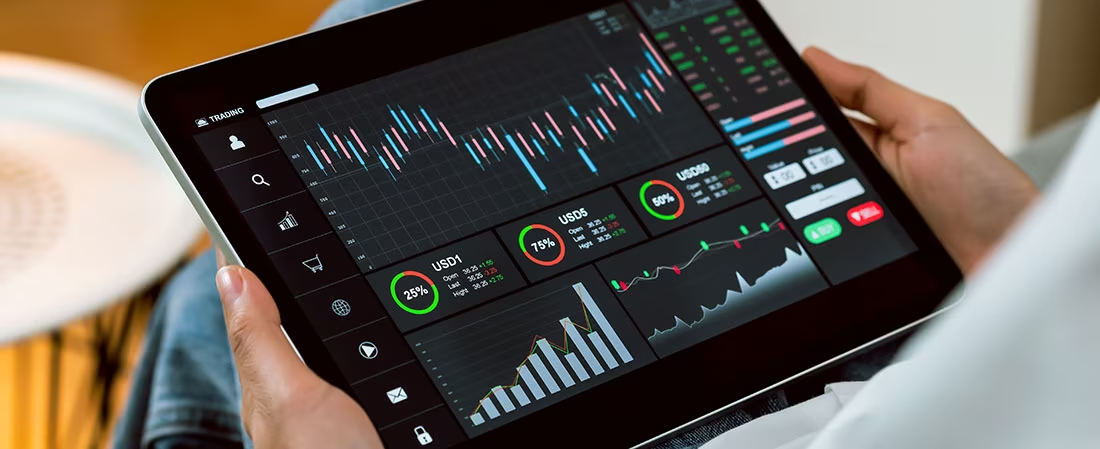The Blog
How to Save Money Without Thinking: Smart Banking and Automated Investment Strategies
Best Micro Investing Apps for Automated Wealth Building
As a mom of two beautiful children, I understand the relentless pressure of juggling daily expenses while desperately trying to build something for our family's future.
Between childcare costs that rival mortgage payments, grocery bills that seem to double overnight, and those gut-wrenching unexpected expenses that always hit at the worst possible moment, saving money can feel like trying to fill a bucket with a massive hole in the bottom.
Even when I was working part-time, I'd watch my paycheck disappear into the endless cycle of bills and necessities. My bank account felt stuck in neutral - never actually shrinking thanks to my income, but never growing either. It was financially surviving, not thriving.
About 5 of years ago, I reached my breaking point with this financial treadmill and decided to explore different options. What I discovered were game-changing companies and apps that automate your savings and investments, requiring almost no daily effort from you.
I made a video about it 2 years ago, which you can see below, but nowadays my money transformation is light years ahead from where I was then!
These online tools have completely transformed my relationship with money. They've grown my savings substantially without forcing me to sacrifice our quality of life or become obsessed with budgeting every dollar. Most importantly, they work in the background while I focus on what matters most - my family.
Today I'll share the exact strategies that worked for me: high-yield savings accounts that actually pay you to save, seamless international money transfer solutions, and micro-investing apps that turn spare change into real wealth.
These aren't just money management tools - they're your pathway to automated wealth building that works even while you sleep.
Part 1. High-Yield Savings Accounts: Your Money Should Work Harder

Traditional banks have been charging fees for everything imaginable - yearly fees, monthly maintenance fees, withdrawal fees, and the list goes on. Meanwhile, your money sits there earning practically nothing while inflation erodes its value. This is exactly why I switched to high-yield savings accounts that actually pay you to save.
Let me explain what APY means and why it matters for your money. APY stands for Annual Percentage Yield - it's simply the percentage your money grows each year when you keep it in that account.
Think of it like this: if you have $10,000 in an account with 4.5% APY, after one year you'll have $10,450 without doing anything.
Here's the eye-opening difference: traditional big banks typically offer around 0.01% to 0.05% APY on savings accounts. That means your $10,000 would only earn about $5 in an entire year.
Meanwhile, high-yield accounts offer 2% to 5% APY - that's 90 times more money earned on the same amount.
Your $10,000 becomes $10,450 instead of $10,005. That extra $445 could pay for a new computer, car repairs, groceries, or can be invested or saved towards your dream vacation.
And if you have $25,000 saved, you're looking at over $1,100 in free money annually, versus just $12.50 at traditional banks!
Varo Bank: My Top Pick for High-Interest Savings
Varo Bank has become my favorite no-fee banking solution. What makes Varo special is their impressive 5% APY on savings accounts that have direct deposit - significantly higher than the national average of around 0.5%. This online bank offers both checking and savings accounts with zero fees, plus some incredible automated features.
The bank allows you to set up automatic savings through their "Save Your Pay" feature. You can choose what percentage of each paycheck automatically goes to savings. Personally, I save half of every deposit that hits my checking account - it goes straight to savings where I watch it compound and grow.
Varo also offers roundups on every purchase, automatically investing your spare change. Their debit card works internationally without transaction fees, which I've tested during my travels to Mexico. Plus, you can receive your paycheck up to two days early, giving you better cash flow management.
Chime: Popular No-Fee Banking
Chime is another solid no-fee banking option that's gained massive popularity. They offer both checking and savings accounts with automatic roundup features and the ability to save a percentage of your paycheck automatically. Chime provides between 1.75% APY to 3.75% APY on savings and allows early access to your paycheck - up to two days early in most cases.
What makes Chime appealing is its widespread acceptance and easy integration with other financial apps. The setup is straightforward, and their customer service has a solid reputation. Like Varo, they're FDIC insured, so your money is protected.
Part 2. International Money Transfers Made Simple

Are you tired of banks charging outrageous fees every time you need to send money internationally? Maybe you've tried Western Union, MoneyGram, or those sketchy money transfer storefronts that charge 10-15% in fees and make you feel like you're doing something illegal.
As someone who owns a home in Mexico, I regularly need to transfer money internationally for property maintenance, utilities, and other expenses. Traditional banks made this process expensive and frustrating with their hidden fees and poor exchange rates.
The situation becomes even more complex when you start earning money online through various platforms - suddenly you're dealing with companies sending you international payments, experiencing currency conversions, and the need to move money efficiently across borders without losing a fortune in fees.
Wise: The Smart Way to Send Money Internationally
If you need to move money internationally, Wise (formerly TransferWise) is a game-changer. Traditional banks charge outrageous fees for international transfers and often use poor exchange rates, essentially stealing your money twice. And some may take many days to complete the transfer.
Wise offers real exchange rates with minimal, transparent fees, and most transfers complete within minutes! I love using Wise because it saves me hundreds of dollars compared to traditional bank transfers.
Here's how the savings add up: when I recently transferred $175 USD to Mexico, Wise charged just $1.58 in fees - less than 1% of the transfer amount - and I received 3,250.32 Mexican pesos using the real exchange rate, within SECONDS.
Compare this to traditional banks that typically charge $25-45 in wire fees alone, plus they use exchange rates that are 3-4% worse than the real rate. On that same $175 transfer, a traditional bank would have cost me around $35-40 USD total - that's more than 20 times what Wise charged.
Beyond the cost savings, Wise is incredibly user-friendly. You can send money using their app or website, track your transfer in real-time, and your recipient gets notified when the money arrives.
They support over 70 countries and 50+ currencies, making it perfect whether you're paying international contractors, supporting family abroad, or managing overseas properties like I do.
The platform also offers a multi-currency account where you can hold and manage money in different currencies. This is particularly useful if you regularly deal with multiple countries - you can receive payments in various currencies and convert them only when exchange rates are favorable.
What makes it even better is their referral program - when you invite three friends to use Wise, you can earn up to $115 in rewards, and your friends get their first transfer FREE.
For anyone dealing with regular international money movements, these referral bonuses can add up to meaningful savings throughout the year.
Part 3. Best Micro Investing Apps for Automated Wealth Building

Saving money in high-yield accounts is just the beginning. To truly build wealth, you need your money working harder through investments.
For decades, investing was an exclusive club reserved for the wealthy elite and those with extensive financial knowledge. You needed thousands of dollars just to open a brokerage account, and financial advisors charged hefty fees - often over 1-2% of your entire portfolio annually - to manage your investments. Many of these so-called "professionals" were more interested in earning commissions than helping you build wealth, pushing expensive products that benefited them more than you.
The beauty of modern investment apps is that they’ve completely democratized investing. Anyone can start investing, even with small amounts, and set up automatic contributions without needing extensive financial knowledge.
On top of that, you can manage your investments easily from your phone or desktop, making it simple to stay on top of your money and watch it grow over time.
Below, I’ll explain why these are my favorite investment apps and how they make getting started so easy.
Acorns: Micro-Investing Made Simple
Acorns caught my attention after seeing it featured on Shark Tank. This app allows you to invest little by little without even feeling it through their innovative roundup system.
Here's how it works: when you spend $4.75 on coffee, Acorns rounds it up to $5.00 and invests that $0.25. These small amounts accumulate until they reach a $5 threshold, then the money gets invested automatically.
You can also set up recurring investments - I started with just $5 per week to ensure I wouldn't miss the money.
And if you're worried about losing money on your investments, the app offers different risk settings:
Conservative (mostly bonds). Conservative portfolios focus on preserving your money with steady, smaller returns - perfect if you're saving for something you'll need within the next few years, you have less time to invest due to your age, or if market volatility keeps you awake at night.
Moderate. Moderate portfolios balance growth potential with some stability, ideal for medium-term goals like saving for a house down payment in 5-7 years.
Aggressive (more stocks). Aggressive portfolios chase higher returns through stocks but come with bigger ups and downs - these work best if you're young, won't need the money for 10+ years, and can stomach watching your balance fluctuate significantly.
Don't know what risk setting you want to choose? As you can see, it depends on your goals. The Acorns app also helps you decide what risk setting you will be comfortable with.
Initially, I chose high-risk settings because I was excited to watch my money grow, but then COVID hit and I started losing money! So I switched to conservative settings for peace of mind. I had never invested before (sadly!) so I hadn't flexed the investing muscle just yet.
As you see, the beauty of Acorns is that you're not locked into your initial choice. Life changes, market conditions shift, and your comfort level evolves. You can adjust your risk setting anytime through the app.
When I switched from aggressive to conservative during COVID, it took just a few taps on my phone. The key is being honest about your timeline and stress tolerance - there's no "wrong" choice, only what works for your specific situation and peace of mind.
Nowadays, I feel more comfortable with a higher risk tolerance, so I changed my settings again, this time to moderate. I've watched throughout the years how my investments go up and down, but in general the trend always ends up being up. I am not losing money at all - most of the time it's temporary setbacks.
In my first year using Acorns, I had over $2,000 saved through these micro-investments - more money than I had ever managed to save in my entire adult life (yes, I'm embarrassed to admit that!). That realization was both exciting and sobering.
I didn't even realize I had that money also... it slowly built up in the background through automated investing with Acorns, plus spare change from my purchases. I was shocked and pleasantly surprised when one day I opened the app at the end of the year.
Here's the truly alarming part: I wasn't alone. The average American has less than $500 in their savings account, and most of that money isn't even invested - it's just sitting there, in a no-yield bank account, slowly dying by losing value to inflation. Most are living paycheck to paycheck, one unexpected car repair or medical bill away from financial disaster.
Let me explain what makes investing so powerful compared to just saving. It's called compounding, and it works like a snowball rolling down a hill.
Albert Einstein famously said:
“Compound interest is the eighth wonder of the world. He who understands it, earns it; he who doesn’t, pays it.”
This is how compounding works: When you invest, you earn returns on your initial money. That is a great win. But the real magic happens when you reinvest those returns instead of taking them out.
Now your money isn’t just earning on the original amount—it’s also earning on the earnings you’ve already made. This “interest on your interest” effect (compounding) can grow your wealth exponentially over time. And the longer your money stays invested, the faster it grows.
For example:
If you invest $5,000 and earn 7% returns, you'll have $5,350 after one year.
In year two, you earn 7% on the full $5,350 (not just your original $5,000), giving you $5,724.50.
And here's where compounding gets truly impressive:
By year 10, that original $5,000 becomes nearly $10,000.
After 20 years, it grows to over $19,000.
And after 30 years? That initial $5,000 investment becomes over $38,000.
All without you adding another penny beyond your original investment!
And the best part? You will be adding money... automatically, using Acorns, remember? So the amount earned will be MUCH higher.
Meanwhile, that same $5,000 sitting in a regular bank account earning 0.01% would only be worth about $5,015 after 30 years - and with inflation, it actually has significantly less buying power than when you started.
The difference between investing and just saving in a regular bank? Over $33,000 in lost opportunity! That's $33,000 dollars you could have made in your sleep! Without working!
As you can see, you can only benefit from compounding if you actually have money invested and growing, not sitting stagnant in a checking account earning nothing. So I highly recommend you try out Acorns today!
Webull: Automated Investing That Taught me to "Pay Myself First"
As you know now, when I first started investing, I used Acorns, and I still use it today for saving money effortlessly through my spare change on my purchases. It is a great introduction to the idea of putting money aside and letting it grow.
But as I got more curious, I wanted to take the next step. That’s when I found Webull.
So, what is Webull?
Webull is a modern investing platform that makes it simple for anyone to start trading and managing their investments. It lets you buy and sell U.S. stocks, ETFs, options, and even fractional shares, without paying any commissions. You can use it on your phone, desktop, or web, so your portfolio is always at your fingertips.
Why I chose Webull as my next step
I’m not an advanced investor, and Webull made it easy for me to grow beyond the basics that I learned with Acorns. The platform gives you powerful tools, but in a way that’s not overwhelming. It also has resources to help you learn as you go, so you feel more confident making decisions.
💡 Pro Tip: I took screenshots of Webull's sections and asked Claude AI and Chat GPT to explain to me in clear language what some terms meant. It was shocking how many leaps and bounds ahead that took me, added to the learning options on Webull already.
Out of all the multiple benefits that Webull provides, here’s what stood out to me the most:
Zero commissions when trading U.S. stocks and ETFs.
No account minimums nor fees for cash accounts, so you can get started with whatever you have.
Up to 8.1% APY on uninvested cash! When you choose Webull premium. That's way better than most high-yield savings accounts.
Fractional shares from as little as $5. You can invest in almost any stock or ETF without needing hundreds of dollars!
Different account types. Cash, a margin account for everyday trading, or a Traditional, Roth, or Rollover IRA for retirement investing.
Access everywhere. Mobile, web, and desktop apps sync seamlessly.
Extended trading hours, letting you invest before the market opens and after it closes.
Paper trading so you can practice investing without risking real money.
How I use Webull
Webull has been revolutionary for my understanding of the “pay yourself first” principle. I’ve set it up so that 10% of everything I earn automatically gets invested before I even have the chance to spend it. That one habit alone has completely changed the way I handle money.
Saving money, and investing it, has become effortless. And it is money I do not touch, but which you can withdraw if needed for emergencies, so it has high liquidity. But of course, if you want it to compound, do your best to leave it alone and watch it grow! It's crazy how $50 to $100 every two weeks easily turns into thousands of dollars.
You can easily link the checking or savings bank account of your choice and set a recurring deposit to your Webull account - every week, every two weeks, once a month, and more.
After that, you can set up the recurring investments of your choice, and also establish the frequency. This approach helped me achieve a 17% return during the past year, well above the market average, by focusing on ETFs like SPY (S&P 500 Index), SCHD (Schwab US Dividend Equity ETF), and VTI (Vanguard Total Stock Market ETF).
These ETFs have become the backbone of my investment strategy, plus some other carefully chosen stocks and funds added along the way. Of course, remember that’s just my personal experience and not investment advice.
I love how Webull makes it so much easier to stick to my plan, stay consistent, and learn as I go. It is exponentially growing my wealth. You'll be surprised how fast you can have $10,000 invested using this method! And that's money that compounds every day.
How money grows in Webull
One thing that’s helpful to understand is how money actually grows inside Webull. When you invest in stocks or ETFs, your money doesn’t “earn interest” every day like a savings account. Instead, your returns come from two places: the price of your investments going up, and any dividends you reinvest. That’s where long-term compounding really happens—by holding, reinvesting, and letting those gains build on top of each other over time.
On the other hand, if you keep cash in your account, Webull also pays interest through its cash sweep program. With Webull Premium, you can earn up to 8.1% APY on uninvested cash (4.1% without Premium).
Interest on your cash balance accrues daily and is paid out monthly, which means every single day your balance is growing a little bit more; even while you’re waiting to decide what to invest in next.
And the best part is that this cash is FDIC-insured (up to $250,000 per bank, with total coverage reaching into the millions through Webull’s partner banks), giving you peace of mind that your money is safe. And because Webull uses multiple banks, your total FDIC coverage can go higher (they typically advertise coverage up to $2.25 million depending on the number of sweep banks).
Important notes: Only your uninvested cash in the sweep program is FDIC-insured. Your investments (stocks, ETFs, options, etc.) aren’t FDIC-insured, but they are protected under SIPC insurance (up to $500,000). Also, all this data is current as of September 2025.
Why you might love Webull too
Whether you’re starting small with fractional shares or thinking long-term with a retirement account, Webull gives you the tools and flexibility to invest at your own pace.
And if you sign up with my link, Webull will even reward you with:
A cash bonus when you make your first deposit of $100
Up to 8.1% APY if you choose Premium
A Webull IRA match to boost your retirement savings
I invite you to let Webull help you take the next step in your investing journey—just like it has for me.
RockWallet: Cryptocurrency Made Simple
RockWallet is a mobile wallet (an app on your phone where you can safely store and manage your crypto) that makes getting started with cryptocurrency easy, even if you’re new to it. A mobile wallet is like your personal digital bank for crypto that stores your digital money securely and lets you access it anytime.
With RockWallet, you hold your own private keys (secret codes that prove you own your crypto). Only you have access to these keys, which keep your funds safe.
The wallet supports a wide range of popular cryptocurrencies, including: Bitcoin, Ethereum, Bitcoin Cash, Ripple, Shiba Inu, and stablecoins like USDT and USDC.
Why Rockwallet is better for your cryptocurrency management
Normally, people often have to switch between different apps to manage multiple digital assets because not every wallet supports every coin. And when sending crypto, you usually need a long, complicated wallet string (a random series of letters and numbers that identify someone else’s wallet). It can be confusing and easy to make mistakes.
RockWallet solves this by letting you manage many cryptocurrencies all in one app and using Paymail addresses (a simpler way to send and receive crypto, using easy-to-remember addresses instead of wallet strings) for sending and receiving, so you don’t have to deal with those complicated strings.
With RockWallet, you can buy, sell, and swap cryptocurrencies directly in the app using your bank account, debit card, or credit card.
The app works on both iOS and Android, so your crypto is always with you, and everything is easy to access and manage. Because it’s self-custody, you have full control and responsibility for your funds, which adds an extra layer of security and peace of mind.
If you’re curious about venturing into cryptocurrencies, RockWallet is a great choice. It’s simple, reliable, and a perfect way to start experimenting, diversify your portfolio, and begin building your digital assets without feeling overwhelmed.
Common Investment Mistakes to Avoid

Why Most People Invest Backwards, and How to Do It Right
Most people approach investing completely backward, which is why Warren Buffett advises doing the opposite of what the masses do.
The typical beginner investor sells in a frenzy when markets crash (selling low, at a loss), and buys when everything is expensive (buying high). This happens because they believe that buying a "successful" stock that is hitting record highs means they are making a great choice, and they sell at a loss because they're afraid of losing more, instead of waiting for the market to rise again.
Smart investors follow Buffett’s advice: “Be fearful when others are greedy and greedy when others are fearful.” In other words, they buy when others are selling and sell when others are buying.
Think of it like shopping: buying a stock when its price is down is like buying it on sale, giving you more value for your money. Buying a stock when it’s at its highest is like buying it at full price, which increases your risk of losing money if the price drops.
By waiting for the right opportunities, investors can take advantage of the market instead of getting caught up in fear or hype. A simple way to start learning is to watch a “successful” stock or ETF when it reaches record highs. Take some time to research its history over the years. Look at factors like:
Stock growth: How the stock’s price has increased over time.
Dividend yield: The percentage of the stock price that the company pays you in dividends each year.
Dividend growth: How much the company has increased its dividend payments over time.
Expense ratio: How much it costs in management fees to hold that stock or ETF each year.
Observe how the stock’s value fluctuates for a few weeks (or even months). When the price goes down, check the news about that company or ETF, and if everything still looks promising, that could be a good time to consider buying.
Of course, there’s a lot more to investing than this; many moving parts affect stock value, and building skill and knowledge takes time and practice.
But you don't have to be an expert investor. You can start slowly and easily with beginner-friendly tools like Webull and Acorns, which make it simple to begin investing while you learn.
Investing Without Checking Key Metrics
Another critical mistake is choosing ETFs or stocks without really knowing anything about them. Many beginners jump in because a stock or ETF looks “hot” or has been making headlines, but they don’t check the key factors that actually affect long-term returns.
One of the most important things to check is the expense ratio. This is the annual fee that the fund charges to manage your money. Even if an ETF offers great returns, high fees can eat away at your profits over time. For most index funds, the expense ratio should typically be under 0.10%—the lower, the better.
Other important factors include:
Dividend yield: The percentage of the stock price that the company pays you in dividends each year. This matters because it shows how much income you could earn while holding the stock.
Dividend growth: How much the company has increased its dividend payments over time. Companies with steadily growing dividends can provide reliable income and indicate financial stability.
Track record / stock growth: How the stock or ETF has performed over the years. This matters because it helps you understand its long-term potential and whether it tends to recover after drops.
1-Year Return (cumulative): Shows how much the stock or ETF has gained or lost over the past year. This gives a snapshot of recent performance, helping you understand momentum—but it shouldn’t be your only guide.
52-Week High and Low: The highest and lowest price the stock or ETF reached in the past year. These numbers matter because they show price volatility and potential opportunities to buy low or recognize if a stock is currently expensive.
By taking the time to research these metrics before investing, you can make smarter choices and avoid letting high fees or poor-performing funds eat into your gains.
Investing is a skill, and it takes practice and knowledge to understand all the moving parts. But you can start slowly and easily with tools like Webull, which makes it simple to see all these metrics and observe the behavior of a stock or ETF over time. This will help you make the best choices, even as a beginner.
The Power of Automated Wealth Building

The beauty of these systems is that they work automatically. You set them up once, and they continue building your wealth without requiring constant attention or financial expertise.
Whether it's roundup investments, automatic transfers to high-yield savings, or scheduled investment contributions, automation removes the emotional element from financial decisions.
The key is starting small with amounts you won't miss. Even $5 per week can grow into substantial savings over time through the power of compounding. As your income increases, you can gradually increase your automated savings and investment amounts.
Important Disclaimers & A Word of Encouragement for You
Even though this isn’t professional financial or investment advice, and shouldn't be interpreted as such, my goal is to help you be many steps ahead of where I was when I finally started saving money and investing. I was like a deer in headlights; completely lost, not knowing what any of this meant or where to begin.
Just knowing the key metrics, having the right tools, and learning these simple tips can give you the confidence to start investing and put you light-years ahead of where I was. It took me years, and quite a bit of trial and error, to learn all this. I want to shortcut the path for you, so you can advance your wealth building faster and with less pain.
Believe it or not, at age 25, I didn’t even know the interest rate on my credit card or what it meant for me. It took years to understand how financial literacy affects your money and long-term wealth. Around 2017, after discovering Acorns, I finally realized the importance of saving and investing - even as a housewife who had little control over her finances, and even though I was living what many would consider a "financially comfortable life".
Before that, when I was single, I had managed to buy my first car and my own house, but not understanding finances cost me thousands through high-interest credit cards and a mortgage that was eating me alive. I slowly regained control, only to lose it again after getting married.
Now, I have a much stronger understanding of money and financial literacy, and I want to help other women and parents like me see how powerful saving automatically and investing early can be.

Even investing as little as $100 a month can grow significantly over time.
For example, if you invest $100 every month starting at age 18, and your investments earn an average of 8% per year, by the time you’re 65, you could have over $350,000. Over 47 years, your total contributions—the money you actually put in—would be about $56,400. The rest, roughly $293,600, comes from growth on your investments—essentially money you earned in your sleep through compounding.
If you increase contributions, earn slightly higher returns, and reinvest your returns through DRIP (Dividend reinvestment program), that total could grow to around a million dollars, showing the incredible power of starting early and staying consistent.
If your goal is to become a millionaire faster, say by age 40, starting early is still key. By investing consistently from age 18 and reinvesting all your returns, you could reach $1 million with about $1,180 per month at an average 8% annual return. And reinvesting your dividends and gains from the beginning through DRIP lets your money grow even faster.
Starting early and staying consistent gives you the power of compounding on your side, turning disciplined monthly contributions into serious wealth over time.
Getting started is easier than most people think, and automated tools can help you do it without stress.
Yes, I wish I had started in my teens—or even my 20s. But the good news is you can start now, take control, and build your wealth steadily. The best time to get started was yesterday. The second best time to get started is NOW. It's never too late to build your financial nest egg. The peace of mind and feeling of safety it will give you to have that extra money growing in the background, is totally worth it!
Just remember: These are simply my personal experiences with different money management tools. Everyone’s financial situation is unique, and you should do your own research and consider consulting with a financial professional before making investment decisions. All the platforms I’ve mentioned are FDIC insured (for banking features) or regulated investment platforms, providing protection for your funds.
However, investments always carry risk, and past performance doesn’t guarantee future results. Remember to consult the Terms & Conditions & Privacy Policy if you have any additional questions.
Good luck on your journey with automated saving and investing! I hope this information helps make it more simple, powerful, and completely doable.

Your Action Plan and Some Helpful Resources
Here's a quick recap of the tools that have transformed my financial life and can do the same for you. These platforms make wealth building automatic, so you can focus on what matters most while your money grows in the background.
High Yield Savings Accounts & Cash Management
Varo Bank
5% APY on savings with direct deposit, no monthly fees, early paycheck access. Sign up and get $25 bonus!Chime
2.0% APY on savings, automatic roundups, nationwide ATM network. Set up direct deposit and get $100 bonus!Wise
Real exchange rates for international transfers, super low fees, supports 70+ countries, multi-currency account. Earn $115 when you sign up and invite 3 friends!Webull
Up to 8.1% APY for uninvested cash with Webull Premium! FDIC insured cash management. Special invite here!
Investment Platforms
Acorns
Automated roundup investing, no experience needed! $5 minimum recurring investments. Sign up and get $5 to start investing!Webull
Zero commission trades, fractional shares from $5, multiple account types (Traditional/Roth IRA), professional trading tools. Automated investing with professional-grade tools. Special invite here!RockWallet
Buy, sell, and store cryptocurrency. Supports Bitcoin and major altcoins, beginner-friendly interface. Cryptocurrency investing made simple, all in one place! Get started with Crypto!
All rates and promotional offers current as of September 5, 2025. Subject to change.
Want to Learn More?
I'm creating detailed guides about choosing winning ETFs, developing investment strategies, and maximizing returns from each of these platforms.
To get notified when these comprehensive tutorials go live, subscribe to my YouTube channel and sign up for the blog newsletter at the bottom of this page - you'll be the first to know when I publish the step-by-step guides that show exactly how I've achieved consistent results.
Remember, building wealth is a marathon, not a sprint. Start with small, automated steps today, and let compound interest work its magic over time.
Your future self will thank you for taking action now rather than waiting for the "perfect" time to begin.
Free eBooks!

And get access to other free downloads, masterclasses and more! Just enter a valid email below.
You can opt-out anytime.
Comments?
My Instagram Feed
Newsletter
Stay in the loop for new videos and special offers! And receive useful tips. Opt-out anytime.
Created with Systeme.io - Click to build yours for FREE today!










